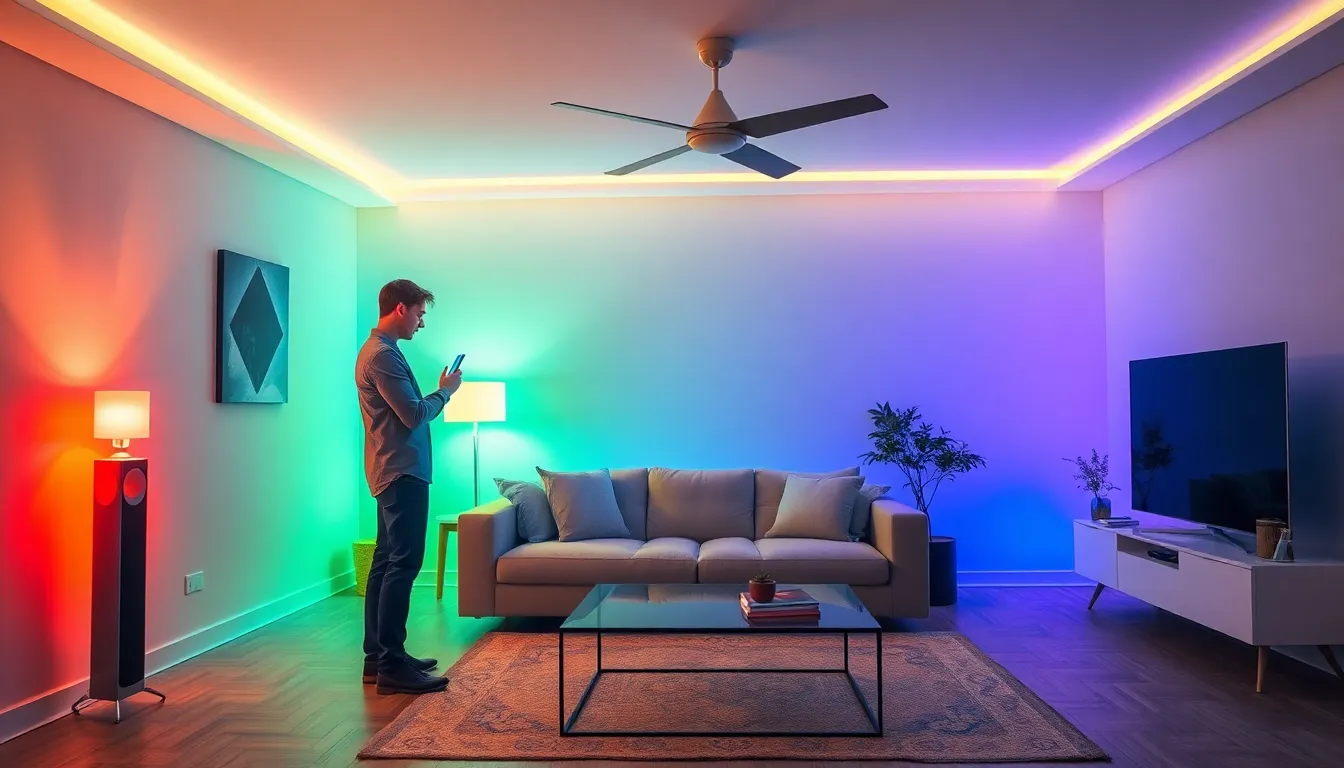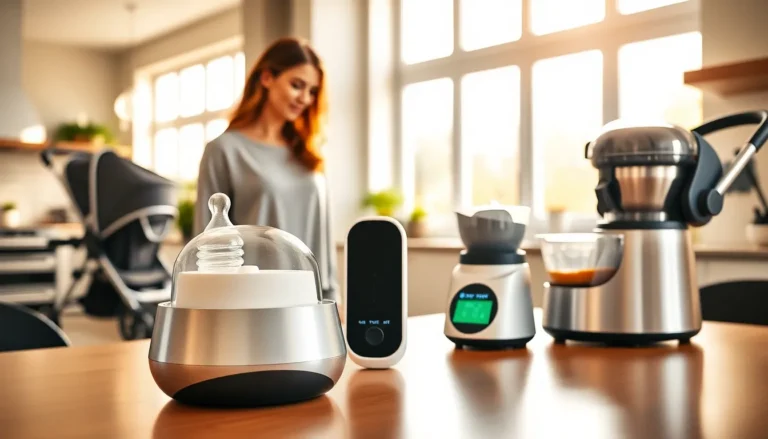Imagine walking into a room and having the lights adjust to your mood without lifting a finger. Sounds like magic, right? Welcome to the world of smart lighting, where technology meets convenience in the most illuminating way. These clever gadgets not only brighten up spaces but also save energy and enhance security.
Table of Contents
ToggleOverview of Smart Lighting
Smart lighting represents a modern solution that adapts to user preferences and enhances the overall ambiance in living spaces. By integrating intelligent features, these systems provide convenience and significant energy savings.
Definition and Purpose
Smart lighting refers to advanced lighting technologies that enable remote control and automation of illumination. They aim to enhance user comfort, save energy, and increase security through customizable settings and programmable features. Smart lighting systems allow individuals to control light intensity, color, and timing, resulting in a flexible environment suited to various activities and moods. Multiple smart devices, such as LED bulbs and lighting strips, can easily adapt to individual preferences, making everyday tasks simpler and more efficient.
How Smart Lighting Works
Smart lighting functions through a network of interconnected devices controlled via smartphones, tablets, or voice-activated systems. These systems often utilize Wi-Fi, Bluetooth, or Zigbee communication protocols to create a seamless experience. Users engage with apps that offer options for scheduling, dimming, and color selection. Sensors in smart lighting systems detect ambient light levels, adjusting accordingly to optimize energy usage. Additionally, integration with smart home ecosystems allows for automation and synchronized lighting with other devices. These capabilities contribute to an enhanced and personalized living experience.
Benefits of Smart Lighting
Smart lighting offers numerous advantages for both functionality and energy management. These benefits enhance user experiences and promote sustainability in everyday living.
Energy Efficiency
Smart lighting systems lead to significant energy savings. Devices equipped with sensors automatically adjust brightness based on the surrounding light levels. According to the U.S. Department of Energy, utilizing LEDs paired with smart controls can reduce energy consumption by up to 80%. Timers and motion sensors also minimize unnecessary usage, ensuring lights turn off in unoccupied rooms. This not only lowers electricity bills but also contributes to reducing overall carbon footprints. With users able to optimize their lighting habits, energy efficiency transforms from a concept into a practical application for modern homes.
Enhanced Convenience
Convenience stands as a key benefit of smart lighting. Users can easily control their lighting through smartphones or voice commands. This hands-free approach allows for effortless adjustments to brightness and color temperature. Scheduling features enable automatic changes throughout the day, aligning lighting with daily activities. When users return home, lights can automatically illuminate to create a welcoming ambiance. Moreover, integration with other smart home devices further streamlines living experiences. Smart lighting adapts to user preferences and daily routines, enhancing comfort and accessibility throughout homes.
Types of Smart Lighting
Smart lighting encompasses various devices that enhance control and flexibility in illumination. The key types include smart bulbs and smart fixtures.
Smart Bulbs
Smart bulbs provide versatile lighting options. They offer customizable colors and brightness, adapting to different moods and activities. Many models integrate with existing light fixtures, making upgrades straightforward. Operating via Wi-Fi or Bluetooth, users control these bulbs using smartphones or voice commands. These devices often feature scheduling options, enabling automation of lighting patterns throughout the day. Energy efficiency is a major plus, with smart bulbs consuming up to 80% less energy than traditional incandescent bulbs. Popular brands, including Philips Hue and LIFX, showcase diverse capabilities, ensuring users find a solution that fits their needs.
Smart Fixtures
Smart fixtures integrate advanced technology directly into lighting solutions. These fixtures often include built-in sensors for automatic adjustments based on ambient light levels. They enhance aesthetics while providing practical illumination. Some models feature smart dimming capabilities, allowing users to change brightness easily. Security benefits arise from fixtures equipped with motion detection, helping deter intruders. Integration with home automation systems ensures seamless operation with other smart devices. Brands like ecobee and Honeywell offer attractive options that combine modern design with smart functionality, appealing to a wide range of consumers.
Integration with Smart Home Systems
Smart lighting systems seamlessly integrate with smart home ecosystems, enhancing user experience and convenience. They interact with various devices, creating a cohesive environment that supports automation.
Compatibility with Voice Assistants
Smart lighting systems easily connect with popular voice assistants like Amazon Alexa, Google Assistant, and Apple Siri. Voice commands enable users to adjust brightness, change colors, and schedule lighting without using hands. These systems respond quickly to spoken instructions, allowing for effortless control. Compatibility enhances accessibility in the home, enabling users to create ambient settings tailored to personal preferences. Many brands ensure regular updates, maintaining compatibility with new voice assistant features to improve user interaction continuously.
Control via Smartphone Apps
Smart lighting offers control through intuitive smartphone apps, providing a streamlined user experience. Users can manage their lighting from anywhere, adjusting settings remotely. Scheduling options enable automation to align with daily routines, such as turning lights on at dusk or off during the night. Additionally, these apps allow for group control of multiple lights, creating specific scenes for gatherings or relaxation. Notifications keep users informed of their energy usage, promoting efficiency and savings. Brands regularly enhance app functionality, ensuring a user-friendly interface and rich features.
Challenges and Considerations
Smart lighting presents challenges that users must consider before implementation. Key factors include initial costs and technical limitations.
Initial Costs
Investing in smart lighting involves upfront expenses that can be substantial. Prices for smart bulbs and fixtures often exceed traditional alternatives, with costs ranging from $15 to $50 per bulb. Setting up a comprehensive smart lighting system may require additional purchases, such as smart hubs or switches, potentially raising the total to over $300. Budgeting for installation and possible professional help further increases initial outlay. Despite these costs, long-term energy savings can offset the initial investment, depending on usage patterns.
Technical Limitations
Technical limitations pose challenges in adopting smart lighting. Connectivity issues can arise, causing devices to lose communication with the network. This situation may lead to inconsistencies in performance. Compatibility problems with existing systems may also frustrate some users, particularly if devices from different brands do not integrate seamlessly. Furthermore, reliance on Wi-Fi means that network outages can disrupt lighting control. Users must consider these operational challenges when selecting devices to ensure a smoother experience.
Conclusion
Smart lighting transforms the way people illuminate their homes by offering convenience energy savings and enhanced security. With the ability to customize lighting through apps and voice commands users can create the perfect ambiance for any occasion. Despite initial costs and potential technical challenges the long-term benefits often outweigh these concerns. As technology continues to advance smart lighting will become an even more integral part of modern living spaces. Embracing this innovation not only elevates home aesthetics but also promotes a sustainable lifestyle through energy efficiency.






